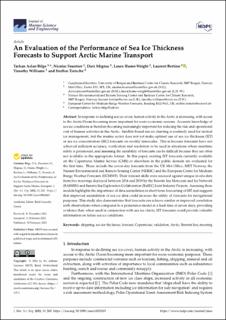| dc.contributor.author | Bilge, Tarkan A. | |
| dc.contributor.author | Fournier, Nicolas | |
| dc.contributor.author | Mignac, Davi | |
| dc.contributor.author | Hume-Wright, Laura | |
| dc.contributor.author | Bertino, Laurent | |
| dc.contributor.author | Williams, Timothy | |
| dc.contributor.author | Tietsche, Steffen | |
| dc.date.accessioned | 2022-04-04T11:08:08Z | |
| dc.date.available | 2022-04-04T11:08:08Z | |
| dc.date.created | 2022-02-17T11:05:46Z | |
| dc.date.issued | 2022 | |
| dc.identifier.issn | 2077-1312 | |
| dc.identifier.uri | https://hdl.handle.net/11250/2989553 | |
| dc.description.abstract | In response to declining sea ice cover, human activity in the Arctic is increasing, with access to the Arctic Ocean becoming more important for socio-economic reasons. Accurate knowledge of sea ice conditions is therefore becoming increasingly important for reducing the risk and operational cost of human activities in the Arctic. Satellite-based sea ice charting is routinely used for tactical ice management, but the marine sector does not yet make optimal use of sea ice thickness (SIT) or sea ice concentration (SIC) forecasts on weekly timescales. This is because forecasts have not achieved sufficient accuracy, verification and resolution to be used in situations where maritime safety is paramount, and assessing the suitability of forecasts can be difficult because they are often not available in the appropriate format. In this paper, existing SIT forecasts currently available on the Copernicus Marine Service (CMS) or elsewhere in the public domain are evaluated for the first time. These include the seven-day forecasts from the UK Met Office, MET Norway, the Nansen Environmental and Remote Sensing Center (NERSC) and the European Centre for Medium-Range Weather Forecasts (ECMWF). Their forecast skills were assessed against unique in situ data from five moorings deployed between 2016 and 2019 by the Barents Sea Metocean and Ice Network (BASMIN) and Barents Sea Exploration Collaboration (BaSEC) Joint Industry Projects. Assessing these models highlights the importance of data assimilation in short-term forecasting of SIT and suggests that improved assimilation of sea ice data could increase the utility of forecasts for navigational purposes. This study also demonstrates that forecasts can achieve similar or improved correlation with observations when compared to a persistence model at a lead time of seven days, providing evidence that, when used in conjunction with sea ice charts, SIT forecasts could provide valuable information on future sea ice conditions. | en_US |
| dc.language.iso | eng | en_US |
| dc.publisher | MDPI | en_US |
| dc.rights | Navngivelse 4.0 Internasjonal | * |
| dc.rights.uri | http://creativecommons.org/licenses/by/4.0/deed.no | * |
| dc.title | An evaluation of the performance of sea ice thickness forecasts to support arctic marine transport | en_US |
| dc.type | Journal article | en_US |
| dc.type | Peer reviewed | en_US |
| dc.description.version | publishedVersion | en_US |
| dc.rights.holder | Copyright 2022 The Author(s) | en_US |
| dc.source.articlenumber | 265 | en_US |
| cristin.ispublished | true | |
| cristin.fulltext | original | |
| cristin.qualitycode | 1 | |
| dc.identifier.doi | 10.3390/jmse10020265 | |
| dc.identifier.cristin | 2002768 | |
| dc.source.journal | Journal of Marine Science and Engineering | en_US |
| dc.identifier.citation | Journal of Marine Science and Engineering. 2022, 10, 265 | en_US |
| dc.source.volume | 10 | en_US |
| dc.source.issue | 2 | en_US |

